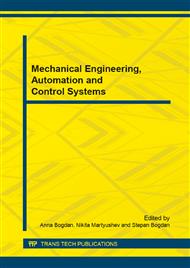p.610
p.615
p.622
p.626
p.633
p.640
p.646
p.652
p.659
Intellectual Control of Oil and Gas Transportation System by Multidimensional Fuzzy Controllers with Precise Terms
Abstract:
In order to improve the pump station control quality a special case of fuzzy controllers has been suggested to use, in which both the input and output variables are represented by a set of mutually non-overlapping terms of the rectangular shape of the membership function (precise terms). As it has been found out there is only one term in this set at any moment of time that is equal to a logical unit, whereas in the production rules system operating such terms, at any arbitrary moment of time, only one production rule antecedent is equal to a logical unit. This allows without losing of the control adequacy in each controller production system scanning cycle not to execute it completely, but solely as far as the rule, whose antecedent at a given moment is equal the logical unit, which also offers immense opportunities to increase the controller speed. In fuzzy controllers with precise terms, unlike the conventional fuzzy controllers the control precision has been shown to be invariant with respect to the complexity of the production rules conditional part structure. It is now clear that precision of fuzzy controllers with precise terms in the control systems as represented by verbal models is compatible with PID-controllers precision while using them to control the linear process facilities.
Info:
Periodical:
Pages:
633-639
Citation:
Online since:
April 2015
Price:
Сopyright:
© 2015 Trans Tech Publications Ltd. All Rights Reserved
Share:
Citation:


